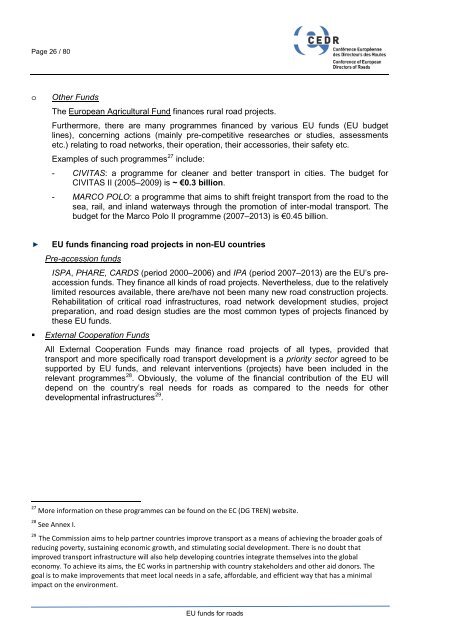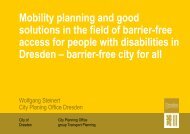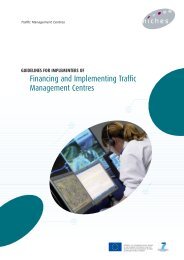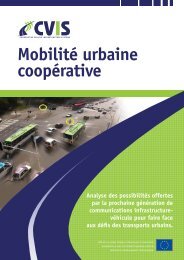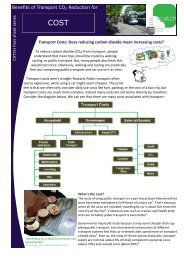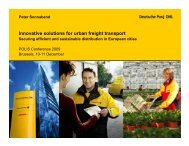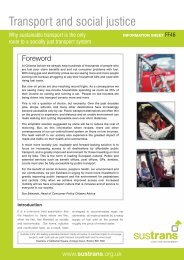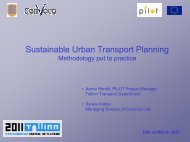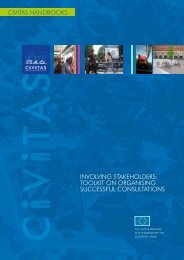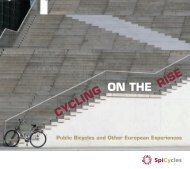EU funds for roads - CEDR
EU funds for roads - CEDR
EU funds for roads - CEDR
You also want an ePaper? Increase the reach of your titles
YUMPU automatically turns print PDFs into web optimized ePapers that Google loves.
Page 26 / 80<br />
o<br />
Other Funds<br />
The European Agricultural Fund finances rural road projects.<br />
Furthermore, there are many programmes financed by various <strong>EU</strong> <strong>funds</strong> (<strong>EU</strong> budget<br />
lines), concerning actions (mainly pre-competitive researches or studies, assessments<br />
etc.) relating to road networks, their operation, their accessories, their safety etc.<br />
Examples of such programmes 27 include:<br />
- CIVITAS: a programme <strong>for</strong> cleaner and better transport in cities. The budget <strong>for</strong><br />
CIVITAS II (2005–2009) is ~ €0.3 billion.<br />
- MARCO POLO: a programme that aims to shift freight transport from the road to the<br />
sea, rail, and inland waterways through the promotion of inter-modal transport. The<br />
budget <strong>for</strong> the Marco Polo II programme (2007–2013) is €0.45 billion.<br />
<strong>EU</strong> <strong>funds</strong> financing road projects in non-<strong>EU</strong> countries<br />
Pre-accession <strong>funds</strong><br />
ISPA, PHARE, CARDS (period 2000–2006) and IPA (period 2007–2013) are the <strong>EU</strong>’s preaccession<br />
<strong>funds</strong>. They finance all kinds of road projects. Nevertheless, due to the relatively<br />
limited resources available, there are/have not been many new road construction projects.<br />
Rehabilitation of critical road infrastructures, road network development studies, project<br />
preparation, and road design studies are the most common types of projects financed by<br />
these <strong>EU</strong> <strong>funds</strong>.<br />
• External Cooperation Funds<br />
All External Cooperation Funds may finance road projects of all types, provided that<br />
transport and more specifically road transport development is a priority sector agreed to be<br />
supported by <strong>EU</strong> <strong>funds</strong>, and relevant interventions (projects) have been included in the<br />
relevant programmes<br />
28 . Obviously, the volume of the financial contribution of the <strong>EU</strong> will<br />
depend on the country’s real needs <strong>for</strong> <strong>roads</strong> as compared to the needs <strong>for</strong> other<br />
developmental infrastructures 29 .<br />
27 More in<strong>for</strong>mation on these programmes can be found on the EC (DG TREN) website.<br />
28 See Annex I.<br />
29 The Commission aims to help partner countries improve transport as a means of achieving the broader goals of<br />
reducing poverty, sustaining economic growth, and stimulating social development. There is no doubt that<br />
improved transport infrastructure will also help developing countries integrate themselves into the global<br />
economy. To achieve its aims, the EC works in partnership with country stakeholders and other aid donors. The<br />
goal is to make improvements that meet local needs in a safe, af<strong>for</strong>dable, and efficient way that has a minimal<br />
impact on the environment.<br />
<strong>EU</strong> <strong>funds</strong> <strong>for</strong> <strong>roads</strong>


